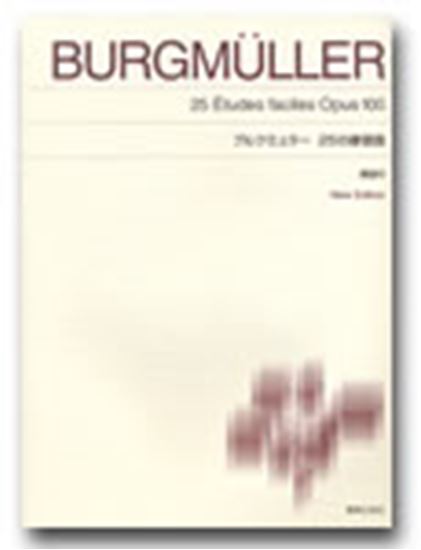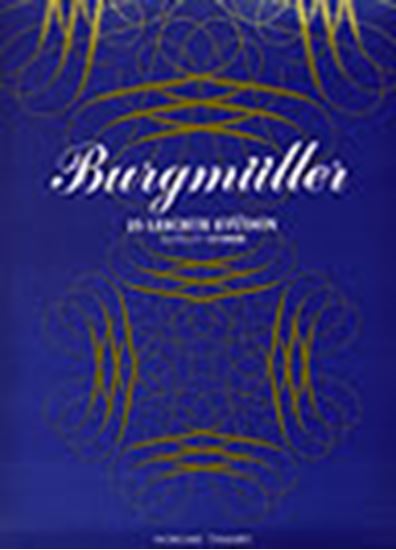Burgmüller, Johann Friedrich Franz : 25 Etudes faciles et progressives, conposées et doigtées expressément pour l'étendue des petites mains Ave Maria Op.100-19
Work Overview
Genre:etude
Total Playing Time:1 min 30 sec
Copyright:Public Domain
Additional Notes:表記ゆれの例: アベマリア アベ・マリア
Commentary (3)
Author : Sato, Takashi
Last Updated: January 31, 2022
[Open]
Author : Sato, Takashi
Without even waiting for the "religioso" (reverently) indication, this piece imitates a choir singing in a Catholic chapel. To express the long reverberation of a cathedral, the use of the pedal will be essential. Master the use of legato pedaling, where the pedal is changed slightly after the key is struck. Colorful altered chords beautifully adorn the piece like stained glass, but the half cadence on the dominant of the VI degree in measure 16 is a particularly miraculous moment.
Performance Points (Original Tempo ♩=100)
- Measures 1-8 feature a four-voice harmony, while measures 9-16 feature a three-voice harmony. Experiment to find the optimal balance.
- Although not indicated in the score, imagine a choir and incorporate natural breaths (pauses) throughout.
- From measure 17 onwards, an eighth-note accompaniment figure is added; be careful, as using the pedal can make this sound noisy.
- Also savor the sound of the mordent on the IV degree in measure 27.
(From To-on Edition "25 Etudes by Burgmüller" (NS70))
Author : Iida, Arisa
Last Updated: March 15, 2018
[Open]
Author : Iida, Arisa
Musical example provided by: Ongaku no Tomo Sha
Author : Ooi, Kazurou
Last Updated: January 31, 2019
[Open]
Author : Ooi, Kazurou
Understanding the Form
- The first half consists of three phrases: mm. 1-2, mm. 3-4, and mm. 5-8.
- The middle section consists of four phrases: mm. 9-10, mm. 11-12, mm. 13-14, and mm. 15-16.
- The second half consists of three phrases: mm. 17-18, mm. 19-20, and mm. 21-24.
- Coda: mm. 25-30.
Understanding Phrase Direction
Next, let's understand the "direction" of each phrase. Direction refers to which note a phrase moves towards or is led to, and it does not necessarily mean that the target note should be played with a louder dynamic.
- For mm. 1-2 and mm. 3-4, the fourth note is the goal note. For mm. 5-8, the first beat of m. 6 is the goal note.
- For mm. 9-10, mm. 11-12, mm. 13-14, and mm. 15-16, the fourth note of each phrase is the goal note.
- For mm. 17-18, mm. 19-20, and mm. 21-24, the direction is the same as in the first half.
- Coda (mm. 25-30): For mm. 25-26, mm. 27-28, and mm. 29-30, the fourth note of each respective phrase is the goal note.
Understanding Dynamics
Next, let's understand the dynamics.
- First Half: Create dynamic differences between mm. 1-2, mm. 3-4, and mm. 5-8. Control the dynamics so that mm. 5-8 are the loudest. However, keep it within the p range and avoid making it too loud.
- Measure 6, with its suspensions and passing tones, becomes a very emotional and endearing section; express this fully. When teaching, play a version without suspensions or passing tones for students to hear.
- The last note of each phrase should be played with a "touching" sensation rather than a strong attack, never applying excessive force.
- Middle Section: Make mm. 11-12 slightly louder than mm. 9-10. This is because the color must change in mm. 13-14.
From m. 17 onwards, be careful not to let the left hand become too loud. Also, be careful not to let the tempo accelerate at that point.
In m. 21, while the inner voices are important, the top voice is more crucial. In m. 24, a staccato is not necessary.
- This staccato should be interpreted as signifying the end of a phrase, serving to distinguish it from the next note.
In m. 27, since it's poco, do not apply too much ritenuto. In m. 30, play slowly, taking a little more time from m. 29.
General Performance Considerations
Analyzing the harmony of this piece reveals that sections with borrowed chords and non-harmonic tones are very emotional and sentimental. Play these sections with deep feeling.
- Examples: mm. 5-6, mm. 13-14, mm. 21-22.
Furthermore, it is crucial to avoid playing in a metronomic fashion (which can make it sound stiff), to prevent flat dynamics, and to always bring out the top voice in chords to highlight the melodic line.
Arrangements & Related Works(6)
PTNA & Partner Channel Videos(19items) View More
Sheet MusicView More
Scores List (26)

(株)東音企画(バスティン)

(株)東音企画(バスティン)

(株)東音企画(バスティン)

(株)全音楽譜出版社

(株)ドレミ楽譜出版社

(株)音楽之友社

KMP(ケイ・エム・ピー) ケイエムピー

(株)ドレミ楽譜出版社

ハンナ(ショパン)

(株)ヤマハミュージックエンタテインメントホールディングス

デプロMP

(株)ドレミ楽譜出版社

(株)全音楽譜出版社

(株)ドレミ楽譜出版社

カワイ出版

カワイ出版

デプロMP

(株)ヤマハミュージックエンタテインメントホールディングス

デプロMP

(株)ドレミ楽譜出版社

(株)音楽之友社

(株)共同音楽出版社

(株)ドレミ楽譜出版社

Neil A. Kjos Music Company




















